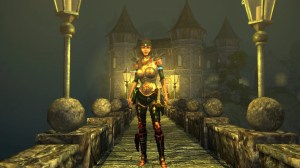The horror genre has gone through many evolutions and trends over the decades, delivering audiences all-new types of frights in ways that often reflect the cultural climate.
Videos by ComicBook.com
In the early 20th century, horror films leaned into classic archetypes of monsters, such as Dracula, The Mummy, and the Wolf-Man, with the genre ultimately leaning more into realism in the ’30s and ’40s. The ’50s embraced more sci-fi elements, likely as a response to the Cold War and nuclear threats, with the ’60s exploring the minds of serial killers.
Thanks to George Romero breaking ground with gore in 1968’s Night of the Living Dead, the ’70s pushed the envelope and helped give rise to the slasher genre, among other notable accomplishments. Additionally, special effects not only allowed for more gruesome gore, but also allowed the scale of films to expand to all-new levels.
Scroll down to see some of our picks for the best horror films of the ’70s!
‘The Exorcist’ – 1973
Based on the William Peter Blatty novel of the same name, The Exorcist is often considered the most effective horror movie of all time, even 45 years later.
After young Regan (Linda Blair) begins demonstrating bizarre behavior, from outbursts of rage to full-blown levitations, her mother seeks the help of the best minds the medical field has to offer. The family finds nothing but dead ends, leading a local priest to intervene, claiming that the young girl has been possessed by a demonic spirit which results in religious leaders taking drastic measures to cleanse the girl’s spirit.
It’s difficult to overstate the many accomplishments of The Exorcist, from its captivating performances to its impressive effects, though the lasting power of the film is likely a result of viewers and their devout beliefs in a higher power, which would seemingly result in the existence of demonic spirits. While some believers feel they have felt the presence of higher powers, The Exorcist and its real-world inspiration depicts what happens when nefarious beings visit humanity and refuse to leave without a fight.
‘The Wicker Man’ – 1973

On the other side of the religious scale, The Wicker Man explored what happens when an outsider is confronted with a culture he’s unfamiliar with and how his experiences both open his eyes and fill him with guilt for his devotion to seemingly arbitrary beliefs.
After receiving a mysterious letter claiming a small child on a remote island has gone missing, a police officer heads to the community to investigate. His investigation raises more questions than answers, with the officer being denied the pertinent information that would lead to discovering the child, while also exposing him to the sex-positive rituals of the community and their worship of nature.
Audiences are delivered a bizarre mystery throughout most of The Wicker Man, with the answers finally becoming clear in the film’s shocking final scene, considered by many to be one of the best twist endings the horror genre has seen. Films have often explored devil worship and mysterious cults, but rarely have they been explored with such whimsy as in The Wicker Man, which will make you question the motives behind even the most polite people you encounter.
‘Black Christmas’ – 1974
Black Christmas might not be the first film to be given the “slasher” moniker, though the film did help develop a tried and true formula, paving the way for films that would go on to define the following decade.
At a sorority house during winter break, a group of students begin to disappear one by one, leading local authorities to launch an investigation into the disappearances. As the body count rises, the film delivers an unexpected revelation about the identity of the murderer, with the premise going on to become the thing of urban legend.
Later in his career, director Bob Clark would deliver audiences A Christmas Story, with this horror film showcasing his talents of capturing seasonal cheer and humor, juxtaposed with grisly violence. One of the earliest films to introduce camerawork from the point of view of the killer, Black Christmas helped establish the budding subgenre that embraced disturbing kills while also delivering a classic whodunit premise.
‘The Texas Chain Saw Massacre’ – 1974

The name of the film says it all, with The Texas Chain Saw Massacre delivering everything its title implies in this sun-baked descent into madness.
A group of weary travelers unwittingly stumble across the Sawyer homestead and its disturbed residents, most famously the chainsaw-wielding Leatherface, delivering audiences a road trip into Hell.
The Texas Chain Saw Massacre might not be the only horror film to depict backwoods cannibals with a penchant for power tools, but filmmaker Tobe Hooper’s portrayal of the American Dream gone wrong in the dilapidated Texan landscape is disturbed, rivetting, and timeless. Additionally, while copious amounts of carnage are depicted, there’s very little blood that makes its way onto the screen, with Hooper’s direction allowing the viewers to imagine the viscera, making the experience all the more frightening.
‘Carrie’ – 1976
Bullied Carrie White (Sissy Spacek) begins her transition into adulthood and discovers that she’s been harboring a secret she was unaware of. After a devastating humiliation at the hands of her classmates, Carrie unleashes her full telekinetic fury upon them, making all those who have wronged her pay for what they’ve done to her.
Carrie would mark a defining moment in the history of horror, as it delivered audiences a tragic performance from Spacek, confident and energetic directing from Brian De Palma, and a clever allegory from Stephen King, who wrote the source novel. All of these names would go on to become legendary names within the genre, with Carrie offering audiences our first glimpses of their greatness.
‘The Omen’ – 1976

Similar to the effectiveness of The Exorcist, The Omen‘s strength lies in its tortured performances, thanks to Gregory Peck, Lee Remick, and newcomer Henry Spencer Stephens as Damien.
When Katherine’s (Remick) child dies shortly after being born, her husband Robert (Peck) instead accepts a child who was born the same day whose mother died during child birth. As the child grows older, bizarre occurrences begin to take place in his vicinity, with a local priest claiming that the boy isn’t even human. As those close to Damien begin to die, Robert is forced to confront the truth about his child and decide if his bond with his “son” is strong enough to ignore his potential evil.
The horror genre earned a stigma in the ’80s as being nothing more than an excuse to titilate viewers with sex and violence, though The Omen demonstrates the effectiveness of taking immensely talented performers and having them explore even the most absurd premises imaginable in the tone of a tense drama. The respect for the genre would dwindle in subsequent decades, with The Omen giving the horror genre a defining story about the son of Satan.
‘Suspiria’ – 1977
Americans weren’t the only ones delivering audiences defining entries in the horror genre, with writer/director Dario Argento crafting a beautifully macabre tale of witches, embracing surrealism for a nightmarish experience.
After Suzy Banyon (Jessica Harper) arrives at an elite German ballet school, she isn’t met with very warm welcomes from the instructors or her peers. As is often the case in horror movies, “mysterious things begin to happen,” with Suspiria depicting Suzy falling ill unexpectedly and maggots falling from the ceiling. Upon discovering that the school used to be run by witches, Suzy finally learns why fellow students have begun to disappear, leading to a tense confrontation that delivers audiences a dizzying frenzy.
From the highly-saturated colors to a whimsical score from Goblin, Suspiria equally dazzles and disturbs with its unique take on classic horror archetypes.
‘Halloween’ – 1978

If Black Christmas helped establish the slasher subgenre, director John Carpenter arguably perfected it with Halloween and its horrors of the dangers that can stalk a small town.
After killing his sister on Halloween night, Michael Myers is locked up in a mental institution, only to escape 15 years later and return to his hometown. Meanwhile, Laurie Strode (Jamie Lee Curtis) aims to have a tame Halloween, only for Myers to pick off her friends one by one for unknown reasons.
Carpenter’s direction and script, which he co-wrote with Debra Hill, set the standard for the subtle slasher that relies on minimalism for its effectiveness. Myers is stripped of his identity completely, hiding behind a white mask and wearing a jumpsuit, leading audiences to wonder what is motivating his murders. Follow-up films would attempt to establish the Myers mythology, though none of them could compare to the effectiveness of the original. The film lends credence to that creepy person you encounter on the sidewalk that makes you feel like you should cross the street, as that person likely wants to follow you home and kill you.
‘Dawn of the Dead’ – 1978
George Romero helped develop the lore of zombies with Night of the Living Dead, allowing him to explore a full-blown zombie apocalypse in Dawn of the Dead.
As societies begin to crumble into chaos due to the dead coming back to life, a group of survivors flee a major city and find refuge in a shopping mall, providing them with all the supplies necessary to survive indefinitely. Despite effectively removing imminent threats, our survivors learn there’s a major difference between “surviving” and “living,” even after obtaining everything they wanted in their pre-apocalyptic life.
Minutes into the film, Romero immerses audiences in the chaos of our failing society, with the worst traits of individuals rising to the surface. Rather than explore how such a crisis could bring humanity together, the film reveals how such a cataclysmic disaster will see the embrace of our deadliest instincts, all while demonstrating a symphony of gore that finds new ways to depict the decimation of dozens upon dozens of characters.
‘Alien’ – 1979

Many of the best horror films of the decade demonstrated impressive special effects, which often depicted gore and violence. Alien, on the other hand, dove deep into its production value to transform intimate sets and an omnipresent feeling of dread to deliver what remains the standard for sci-fi survival horror.
Hundreds of years into the future, a team of researchers crosses paths with an alien entity, which infiltrates the vessel by the way of impregnation. After a small creature bursts out of the chest of a crewmember, it quickly matures and begins to kill them off one by one.
From the direction of Ridley Scott to the creature design of H.R. Giger to the ferocious performances by Sigourney Weaver, John Hurt, and the rest of the ensemble cast, Alien depicted the terrors of technology and humanity’s attempt to explore uncharted corners of the universe. The film delivers countless astounding makeup techniques, yet its ultimate success is in what it doesn’t show you, with the darkness of the ship and its many unseen alcoves causing viewers to peek around every corner they encountered thereafter.








